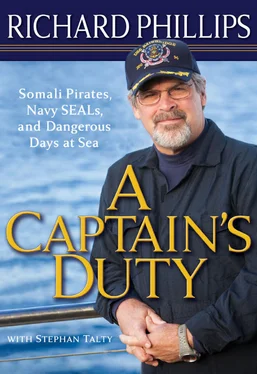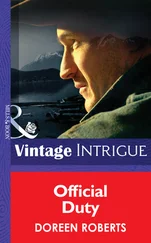When I was coming up in the service, I met guys who’d served in World War II and had ships shot out from beneath them. And I remember what one guy told me: “I was in the merchant marine when the war broke out and I saw ships going down left and right. I got so scared I joined the navy.” He was just playing the odds. Being a merchant mariner was a good way to meet your maker in those days.
A lot of us have a chip on our shoulder. We’re patriots. We have a proud tradition. We’re rugged individualists with a few mixed nuts thrown in to keep it interesting.
But we never make the headlines.
On that trip to the Maersk Alabama, I had one of those history books packed in my carry-on luggage, but I sat on the plane thinking about what I had to do once I got aboard. My flight left at 3 p.m. I was headed to Salalah, Oman, on the east coast of the Arabian Peninsula, where the ship was loading up its cargo holds. I’ve flown as long as forty-two hours to get to a ship, and this time the journey was nothing unusual: Burlington to Washington, D.C., D.C. to Zurich, Zurich to Muscat, Oman, where I crashed at a hotel for ten hours. The next morning, I headed straight back to the airport for the flight to Salalah. I left Vermont on March 28 and arrived at my destination on the thirtieth. Wherever there’s work as a merchant mariner, you go. Joining me on the trip was Shane, my chief mate and an able-bodied seaman, who was also headed to the Maersk Alabama .
I rolled out of bed on March 30, my brain cloudy from jet lag, and jumped in a car that took me to my ship. The Maersk Alabama was sitting at the dockside, its two cranes swinging containers onto the deck, when I walked up the gangway, boarded the ship, and went up to my office to meet the relieving captain, who debriefed me on what was going on. The captain left and I dumped my gear in my quarters, which were connected to an office, one floor below the bridge on the starboard side. To get from my room to the ship’s bridge, all I would have to do is walk down the hallway to the center door. Opening it, I’d be in the chimney, or central ladder way. One flight up and I’d be on the bridge, the command center for the whole ship.
The house was what we call the seven-story superstructure at the stern (or rear) of the ship. A small condolike structure, it contained our living quarters, our mess hall, and our hospital. The top level was the bridge, where large windows ran from the ceiling to about waist-high and were met by a metal wainscoting that dropped to a special antifatigue rubber floor. (Watches are kept on the bridge, where a mate and an AB, or able-bodied seaman, are constantly scanning the horizon, so you want them to stay alert.) It looked like a greenhouse in there, with views for miles in every direction. In the middle of the bridge was the conning station—that’s where we steer the ship from—and a flat electronic console filled with navigation aids. That’s where you’d find the radar. Radar doesn’t look like the cathode tube setup you see in Humphrey Bogart movies. These days it looks more like a TV, with ships still appearing as a small blip, but now with data streaming down the right side of the screen: the speed of any vessels, CPA (closest point of approach, which tells you the point at which you’re going to intersect with that approaching ship), and time to CPA. On the port side stood a chart table, where the second mate—the office man on a ship—does his work. There was a GMDSS, or Global Maritime Distress and Safety System, which gave us continuous weather updates, a small electronic station, which replaced the traditional radio operator, and a computer.
Starboard there was an all-important piece of equipment: the coffeepot, my first stop every morning.
Port and starboard, doors led off to the bridge wings, walkways eighteen feet long that we used while maneuvering or docking. These wings allow you to see down the sides of the ship and avoid banging into the piers or another vessel. Above the bridge was the flying bridge, an open platform that marked one of the the highest points on the ship.
Each deck below the bridge was designated by a letter. My quarters were housed on E deck. The chief engineer’s, too. The engineers’ and mates’ rooms were on D deck. C deck held quarters for the crew, while B held more space for the ABs and the vessel lounges. A deck housed the mess, where we ate our meals, and the hospital. On the main deck was the ship’s office. Dropping below the deck into the belly of the ship, directly below the house, sat the engine room. Forward of that were the enormous cargo holds, with tanks holding ballast, fuel, and water underneath. Behind, or aft, of the engine room, under the main deck, was the after steering room.
I spent the next few hours going over the Maersk Alabama with a captain’s eye. The first thing I noticed was that the ship had let the security slip a little. I could see doors open all over the ship. The engine door, the bridge door, the cargo scuttle that led into the holds—they were all key points of entry for any intruders and they were all standing wide open. Even though we were in port, they should have been secured. The pirate cages were unlocked, too. Pirate cages are steel bars over the ship’s ladder ways that come up from the main deck to the superstructure on the exterior of the ship. After you climb up a ladder, you’re supposed to lower this screen of welded bars over the hole you’ve just come through and lock it. These screens are designed to keep any intruders from ascending the ship to the bridge.
I’d captained the Maersk Alabama once before and I knew her pretty well. She was a container ship, one of the workhorses that carry the Toyota you’re driving, the plasma TV you’re watching, or the Reeboks you’re wearing. (Without the merchant marine, there is no Walmart.) Merchant mariners don’t get to sail the beautiful ships of the world, the yachts and sloops and the rumrunners. We don’t get to stand at the helm with a gin and tonic in our hands. We work trawlers, barges, bulk carriers, tankers. The Maersk Alabama was built in China ten years ago; it was 508 feet long and 83 feet abeam and painted blue on the hull and beige on the superstructure, like all the ships owned by Maersk. Two 40-foot cranes, each six stories high, were placed fore and aft, which enabled us to quickly load and unload the containers that sat on top of the deck on any given trip. Her top speed was eighteen knots, powered by a single diesel engine, and her capacity was 1,092 TEUs, or twenty-foot equivalent units, which meant she could carry approximately 1,092 of the containers you see stacked at ports or being pulled by tractor trailers across America. This ship was like a thousand other vessels out there, but for the next three months it was going to be my home, my job, and my responsibility.
We were on the EAF4 run (East Africa 4), which went from Salalah, Oman, to Djibouti in the Republic of Djibouti and Mombasa, Kenya, on the Indian Ocean. Sometimes we’d include Dar es Salaam on the trip, but this time it was only three stops. I’d always found East Africa to be a good run, relaxing even, compared with hauling cars from Yokohama to the United States on a nail-biting schedule. The trip promised sunny weather, interesting ports, a solid ship. It was one of the best runs I’d ever been on, and I felt lucky to have it.
We were carrying seventeen tons of cargo, including five tons of supplies for the World Food Programme, what we call “handshake food”: grain, wheat, peas, the essentials for survival. From those ports the food would be trucked hundreds of miles into countries like Rwanda, Congo, and Uganda, land-locked places that can’t get the stuff any other way. Every piece of merchandise—every lightbulb, every pair of shoes, and every gallon of gas—that ends up in those countries has to go through two ports, Mombasa or Dar es Salaam. I later heard from one Catholic relief outfit that had twenty-three containers onboard the Maersk Alabama destined for Rwanda. They told me it was their entire six-month supply for the refugees they cared for and if it was delayed or hijacked, some of those desperate men, women, and children would have starved to death.
Читать дальше












